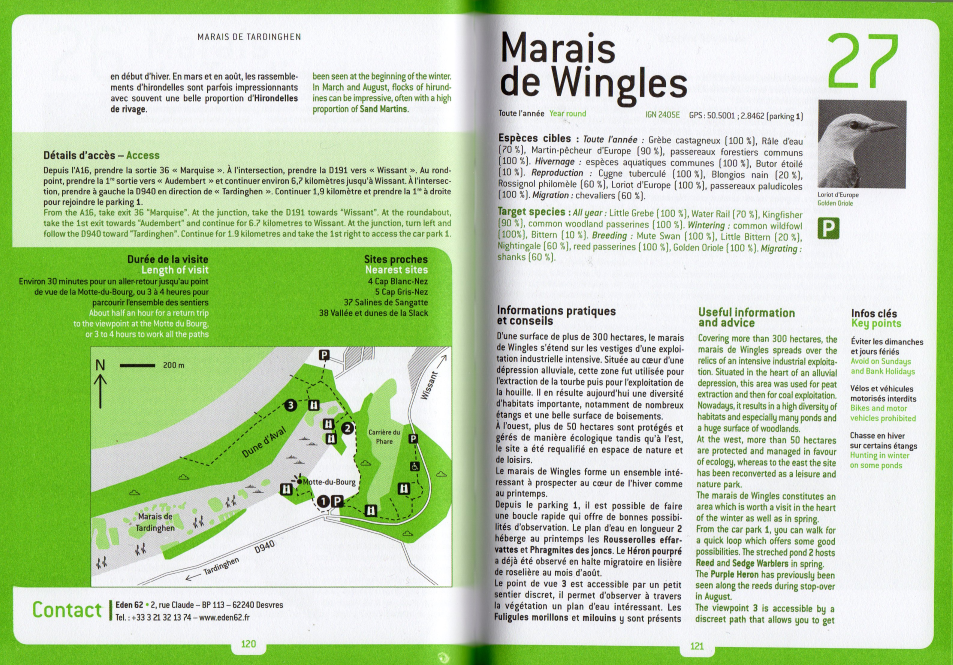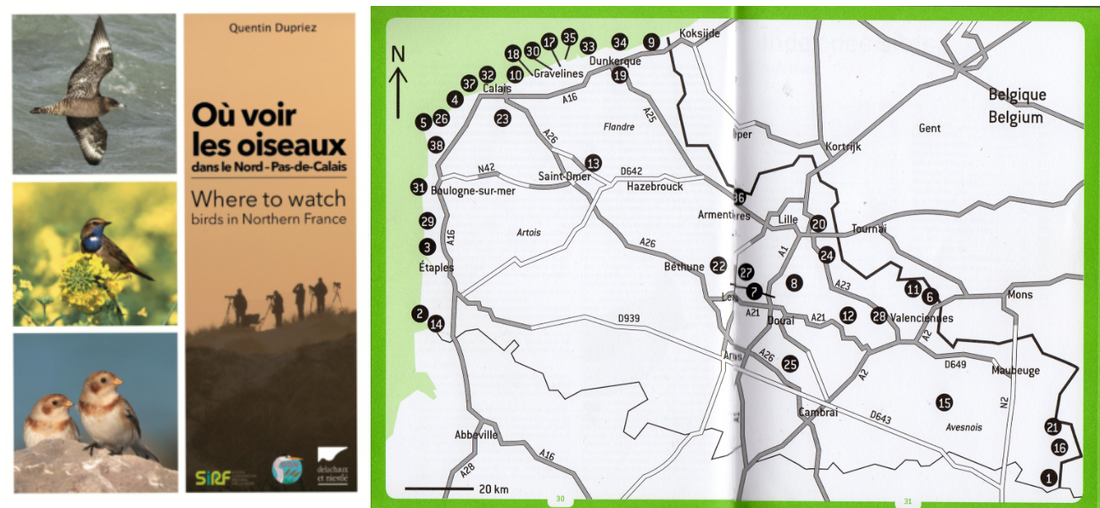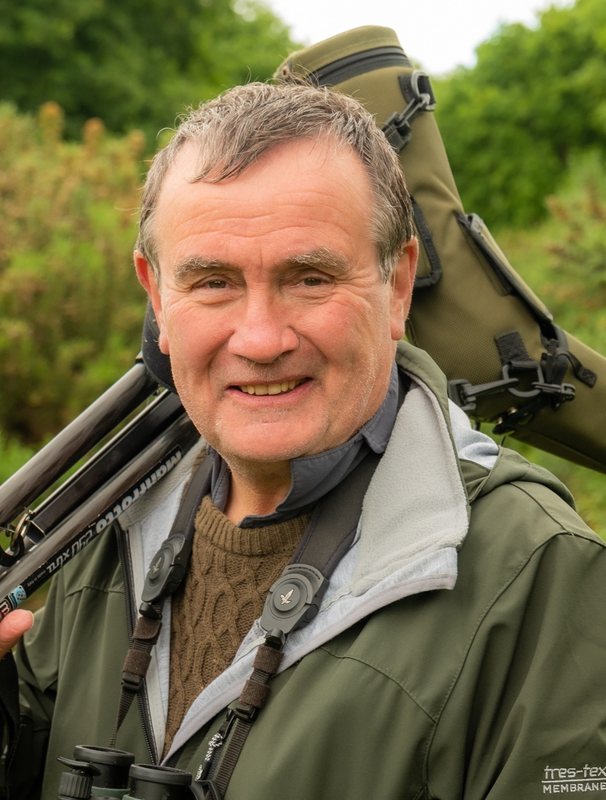
Before I got the Spain bug I used to pop over to France a couple of times a year for a fix of exotic birds like Golden Oriole, Bluethroat, etc. I even wrote up my notes and put them on the internet where they continued to be used well after their sell-by-date simply because there was relatively little available in English. This has oversight has now been handsomely remedied with the publication of this excellent and remarkably up-to-date new guide. Whilst most visitors to Spain fly or take the ferry directly to Santander or Bilbao, for those who drive down via Calais this book gives you some good ideas for some birding whilst you wait for your crossing.
The first thing to note is that the English title is somewhat misleading as it covers only the département of Nord – Pas de Calais (a kite like wedge running NW-SE measuring roughly 200 by 100 km). This means that some well known sites only an hour or so from the Channel Tunnel (e.g. Parc Ornitologique Du Marquenterre, Somme, Picardie) are excluded, but other sites hard against the Belgian border, and 2½ hours away by car, are covered. It should also be recognised that the book's written from a French point of view so several blocks of woodland of interest to British visitors near Boulogne and Calais are ignored as, in a broader French context, their birdlife is relatively mundane. The English text, is generally very good with only the occasional “forced” expression, but one necessary concession of a bilingual book is in evidence; the typeface is rather small. This is further compounded by the English being printed in green (the French text is black). Several of the maps too seem to have been so reduced from the original that the text on them is sometimes so small to be near illegible. The author has also used IOC International English names, rather than vernacular British ones, which means several species have American names unfamiliar to most British users (e.g. Red Phalarope) The index lists birds by their species, not group, name so, as a result, to find references to Arctic Skua you need top look under 'P' for 'Parasitic Jaeger'! This seems to me to be a mistake given that most using the English text will be British.
The book follows the well established format of such guides with a short introduction followed by a month-by -month 'birdwatcher's year' (14 pages) and then the 'meat' of the book, a description of sites and their birds (138 sites covered in 130 pages). Somewhat less usual is the very full species list (24 pages) in table form giving the status, divided into seasons, of the 420 species recorded in the region. This format works well enough for commoner species, but less so for rarer ones. It's fascinating to discover which rarities the area has in common with adjacent parts the UK (e.g. Pallas's, Radde's and Dusky Warblers, Red-flanked Bluetail, etc) and, even more so, which ones it doesn't (e.g. Steller's Eider, Barrow's Goldeneye, Hazel Hen, Pygmy Cormorant, Black-winged Kite, Long-legged Buzzard, both Spotted Eagles, etc.)
The site accounts starts with a short list of 'target species' (grouped by season) and a gives a % chance of recording the species (or group) so listed. It's always debateable how accurate such percentage system can be depending as it must on a number of variables (e.g. observer competence, weather, etc.), but it certainly helps to highlight the possibilities. In the margin there are various useful warnings and comments (e.g. avoid weekends, keep on paths etc). Hunting is far more popular in this region than in the UK and birders are warned to avoid the hunting season at several sites, but when this might be isn't clearly stated. These sites are depicted by a map with numbered locations linked to the text. Woodland is shown in bright green, and, disconcertingly, water bodies are in pale green which can be misleading at first glance. Urbanisations, roads, mudflats and spoil tips are clearly marked in black-and-white or grey. These maps are excellent for negotiating the sites themselves, but are of limited use for actually finding the site – a supplementary map showing general location would have been helpful. There is a double page map showing the department, but the scale is too great to be useful for giving finer details of the location. A description of the location is given, but for the visually orientated a map would have been more helpful. This brings me on to the book's Achilles heel; for some mystifying reason sites are covered in alphabetical order and then shown by number (1-38) on the location map As a result Site 1 'Anor' is in the far SE of the region hard against the Belgian border, but Site 2 'Baie d'Authie' is on the Channel coast. Had they been listed and numbered by their appearance along the coast and then inland sites from east to west then the number alone would have alerted the reader to the site's approximate location. As it is you need to constantly turn to the map to grasp whereabouts the site may be – a process not helped by the only copy of the map being buried in the text. It's in a logical place, but an additional version easily located at the back of the book would have helped. One nice idea is that at the end of each account the names & number of nearby sites is given – a very useful feature. Another helpful feature is that species are highlighted in bold making is easy to zoom in to the relevant section if you have a 'hit list'.
It may come as a surprise to British birders, but from the French point of view le Nord – Pas-de-Calais, particularly along the coast, is a birding hot spot. It is, in some ways, the French equivalent of the North Norfolk since it has a good record for birds like Yellow-browed Warbler, eastern warblers, etc. and not surprisingly so given its location on the continental coast and facing the North Sea. Happily, from a British point of view, it's also home to birds that are scarce, rare or even unrecorded in the UK. The scarce birds include sought after birds like Bluethroat and Golden Oriole, the rare ones species such as Little Bittern, Black Stork, Fan-tailed Warbler and Crested Lark whilst non-British species are represented by Eagle Owl, Black and Middle-spotted Woodpeckers. Not, perhaps, too exciting if you're heading through France for Spain, but surely still worth a look. Most of these valued species can easily be seen within sight of the Channel (exceptions being Eagle Owl, Little Bittern,Black Stork and Middle-spotted Woodpecker). This dominance of the coast for rarities perhaps helps to explain why, of the 38 sites covered, 18 are on or very near to the coast (and another three within 10 km of the Channel). Accordingly none of these sites are more than a few km from one another (arguably some could even have been amalgamated to save space). Further inland, but still only c40 minutes from the coast, are the Etangs de Romelaere (St Omer) where Little Bittern and Great Reed Warbler can be found. Next comes a broad cluster of a dozen sites around Lille and Valenciennes which are between 1 – 1½ hours- from the Channel. A little further afield is the Foret de Mormal (c2 hours)whilst to the south-east, and hard against the Belgian border, are three further sites (c2½ hours). Other than those visiting for the weekend or longer, British visitors will be most interested in those sites within an hour or so of the Channel tunnel and Calais.
Despite the caveats expressed above, this is an excellent and very handy guide to the area. Yes, it is disappointing from a British point of view that good sites in the Somme, or even just over the birder in Belgium, are omitted, but that is handsomely made up for by the wealth of detail about those areas it does cover. It has all the information you need to enjoy a productive visit to well known sites (e.g. Cap Gris-Nez, Platier d'Oye), but adds plenty details for less familiar ones too (e.g. Hems-Saint-Pol which only came into being in 2012). Those that have visited the area previously, even regularly, will find plenty of new information both about birding sites and birds – who would have guessed that old spoil tips around Lille were so good for Ring Ousels? Those arriving with fresh eyes will be surprised just how many less familiar species can be found after that short hop over the Channel. Braver souls might want to escape the tyranny of the British list and try a little autumn birding on the French Channel coast, they may be pleasantly surprised. Highly recommended. Available from Amazon or NHBS (http://www.nhbs.com/)


 RSS Feed
RSS Feed
